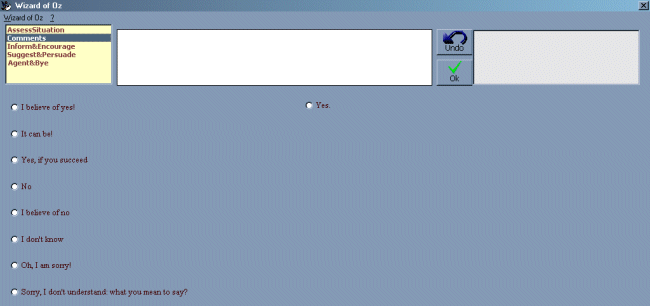University of BariDepartment of InformaticsIntelligent Interfaces | |||||||||||||||||||
| Home | Research | People | Meetings | Projects | |||||||||||||||
Wizard of Oz studies with ECAs |

|
| ||||||||||||||||||||||||||||||||||||||||||||||||||||||||||||||||||||||||||||||||||||||||||||||||||||||||||||||||||||||||||||||||||||||||||||||||||||||||||||||||||||||||||||||||||||||||||||||||||||||||||||||||||||||||||||||||||||||||||||||||||||||||||||||||||
Overview | ||
|
||
|
Objective | ||
| ||
|
Participants | ||
| ||
|
Architecture and Language | ||
This tool is based on a client-server architecture, is written in Visual Basic 6.0 and uses several libraries and components (see figure). | ||
|
Publications | ||
|
|
When both the applications have been started and the connection has been established, the experiment may begin. The user playing the role of the Wizard selects one of the available agent moves in the hierarchical menu by clicking on it: the corresponding apml file is then sent to the subject side and the haptek wrapper executes it. Subjects may respond, in their turn, with the initially selected modality (text or speech input) and the dialog between the ECA and the subject goes on, by alternating the two participant's moves. When the subject wants to stop the dialog, he or she may click on the “Stop the dialog” button: a final questionnaire to be filled will then be displayed. The questionnaire results are sent to Oz when the subject clicks on the
“Confirm Evaluation” button. | |||||||||||||||||||
| Home | Research | People | Meetings | Projects | |||||||||||||||